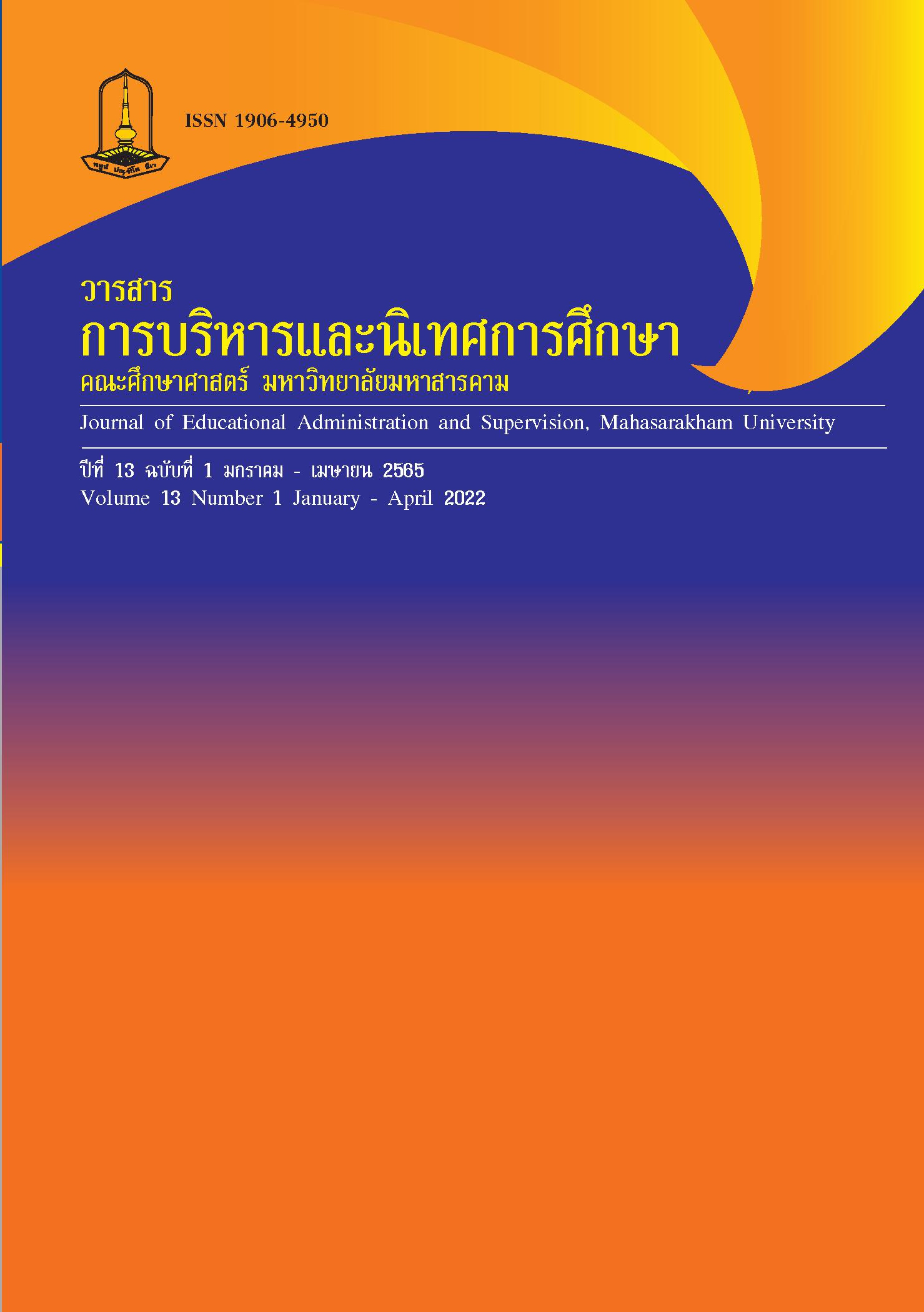Innovative Leadership of School Administrators Affecting High Performance Organization Under Yasothon Primary Educational Service Area Office 2
Main Article Content
Abstract
This research aimed to study the Innovative leadership of school administrators affecting high performance organization under yasothon primary educational service area office 2. The sample group was 327 administrators and teachers in yasothon Primary Educational
Service Area Office 2. The tool used in this research was the Likert scale question. Reliability
from the Likert scale question on the Innovative leadership of school administrators was.95
and high-performance organization was.95 The statistics used in this research were mean,
standard deviation, and Stepwise Multiple Regression analysis. The results of the research were as follows.1. the Innovative leadership of school administrators in Yasothon Primary Educational Service Area Office 2 in overall was high and each side also was also in high level as well. The side with the highest mean was technology and communication and the side with the lowest mean was commanding power creating Organizational Climate.2) The high performance organization in yasothon primary educational service area office 2. in overall was high and each side also was also in high level as well. The side with the highest mean was leading the organization and the side with the lowest mean was process management and action results. 3) The result from setting up equations predicting high performance organization in yasothon primary educational service areaoffice 2. indicated that the Innovative leadership of school administrators in technology and communication (X4), teamwork and participation (X3), and creating Organizational Climate (X5) could predict high performance organization in yasothon primary educational service area office 2 (Y) to be 79.60% with statistical significance level.01 and the predicting equations could be written as follows.
Predicting equation in raw score form:
Y´ = 0.694 + 0.375X4 + 0.303X3 + 0.178X5
Predicting equation in standardized form:
Z´y = 0.389ZX4 + 0.317 ZX3 + 0.206 ZX5
Downloads
Article Details
References
ชวลิต โพธิ์นคร (2560). การศึกษาในยุคไทยแลนด์ 4.0. (Online). https://km.li.mahidol.ac.th/thai-studies-in-thailand-4-0/. 3 ธันวาคม 2563.
ฐิตินันท์ นันทะสี และคณะ. (2563). ภาวะผู้นำเชิงนวัตกรรมของผู้บริหารสถานศึกษา. วารสารบัณฑิตศึกษา มหาวิทยาลัยราชภัฏสกลนคร, 17(1), 11-20.
บุญชม ศรีสะอาด. (2556). วิธีการทางสถิติสำหรับการวิจัย เล่ม 1. กรุงทพฯ: สุวีริยาสาส์น.
ปริวัฒน์ ยืนยิ่ง (2563). ภาวะผู้นำเชิงนวัตกรรมของผู้บริหารสถานศึกษา วิทยาลัยเทคนิคอุบลราชธานี. วารสารนวัตกรรมการศึกษาและการวิจัย, 4(3), 330-334.
ปวีณา กันถิน และคณะ. (2560). ภาวะผู้นำเชิงนวัตกรรมของผู้บริหารสถานศึกษาโรงเรียนประชารัฐเขตพื้นที่การศึกประถมศึกษาเชียงใหม่ เขต 5. วารสารวิชาการ มนุษย์ศาสตร์ สังคมศาสตร์และศิลปะ, 10(3), 1833-1848.
ไพฑูรย์ สิลลารัตน์. (2559). การศึกษาไทย 4.0 ปรัชญาการศึกษาเชิงสร้างสรรค์และผลผลิตภาพ. กรุงเทพฯ: โรงพิมพ์แห่งจุฬาลงกรณ์มหาวิทยาลัย.
สำนักงานคณะกรรมการการศึกษาขั้นพื้นฐาน. (2561). งานศิลปหัตถกรรมนักเรียนระดับชาติ ครั้งที่ 69. (Online). https://esan69.sillapa.net/sm-esan/. 12 กรกฎาคม 2563.
สำนักงานเขตพื้นที่การศึกษาประถมศึกษายโสธร เขต 2 (2561). ผลทดสอบคะแนนโอเน็ต. (Online). http://www.yst2.go.th/web/?page_id=3705. 10 กรกฎาคม 2563.
สุรียะ ทวีบุญญาวัตร และประเสริฐ อินทร์รักษ์. (2559). รูปแบบองค์การขีดสมรรถนะสูงของโรงเรียนมัธยมศึกษาสังกัดสำนักงานคณะกรรมการการศึกษาขั้นพื้นฐาน. Veridian E-Journal มหาวิทยาลัยศิลปากร, 9(1), 795-814.
อรอนงค์ โรจน์วัฒนบูลย์ (2553). การพัฒนาตัวแบบผู้นำเชิงนวัตกรรม. วิทยานิพนธ์ปริญญารัฐประศาสนศาสตรดุษฎีบัณฑิต สาขาวิชารัฐประสาสนศาสตร์ สถาบันบัณฑิต พัฒนบริหารศาสตร์.


